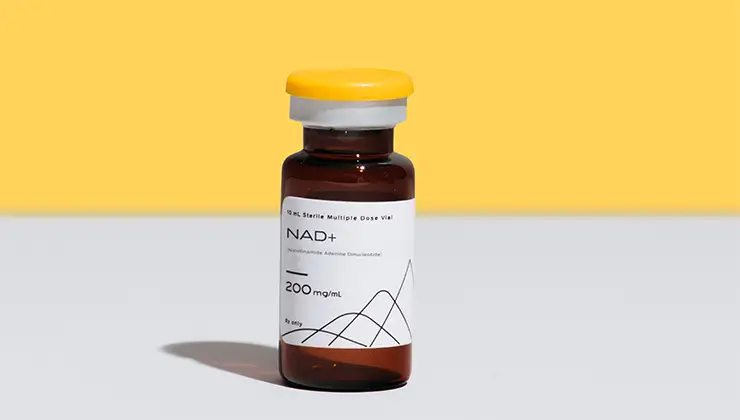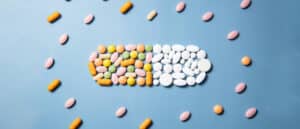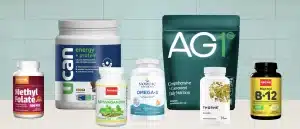What the Heck Are NAD+ Precursors—and How Can They Help You Age Better?
- By Jennifer Chesak
- Medically reviewed by Jack Jeng, M.D.
- August 15, 2022
If you’ve been reading up on the best ways to live longer, chances are that you’ve come across NAD+(nicotinamide adenine dinucleotide)—a crucial coenzyme that plays a role in major biological processes including the stress response, cell survival, metabolism, immune system activity, DNA repair, and more—and its precursors like NM and NR. But what is a precursor—and how can NAD+ precursors boost longevity?
It’s less complicated than you think.
A precursor is a substance, cell, or component from which another is formed in a chemical reaction.
Think of them like ingredients in a recipe. To make a killer rack of ribs, you need low steady heat and a seasoning rub with some sugar. When the meat cooks, the sugar caramelizes. Skip the sweet stuff, and your ribs won’t be nearly as tasty (or as messy).
It’s similar with NAD+. Your body takes micronutrients and substances from food and supplements—these are the NAD+ precursors—and, through a series of chemical reactions, turns them into NAD+.
There are five NAD+ precursors to know about:
- Nicotinic acid (NA)
- Nicotinamide (NAM)
- Nicotinamide riboside (NR)
- Nicotinamide mononucleotide (NMN)
- Tryptophan
In addition to these precursors, your body also recycles some NAD+ through what’s called the salvage pathway. After enzymes consume NAD+ for all those important physiological processes we listed above NAD+ becomes a byproduct that is actually a precursor, which then gets converted to NAD+ again (2).
Why does all of this matter? As you age, you lose NAD+, making you more vulnerable to age-related diseases. You can stave off some of the decrease through diet, exercise, and by supplementing with NAD+ itself, or getting more of its precursors (1).
Precursors at a Glance
- Precursors are components from which other substances are formed.
- Your body takes NAD+ precursors and, through a series chemical reactions, turns them into NAD+.
- There are five NAD+ precursors; NA, NAM, NR, NMN, and tryptophan.

It should be. NAD+ may boost energy, increase lifespan, help with weight loss and improve brain function. Now available through Hone.
NAD+ Precursors
NAD+ precursors include several forms of vitamin B3, as well as tryptophan, an amino acid found in milk, nuts, cheese, and meats.
Each precursor is synthesized through a slightly different pathway and is responsible for different, although sometimes overlapping, physiological processes (2).
Before adding supplements to your diet, you should talk to your health care provider, especially if you have underlying conditions or take prescription or over-the-counter medications.
Nicotinic acid (NA)
Nicotinic acid—also known as vitamin B3 or niacin—is found in meat, fish, poultry, whole grains, nuts, and more. NA was discovered by researchers studying nicotine, but that’s where the relation to smoking ends (3). Many foods, like bread and flour, are fortified with niacin.
Niacin deficiency is rare in the United States; most men hit the recommended 16 mg per day through food. But if you’re short on the nutrient, it can cause depression, fatigue, headache, and memory loss.
A severe deficiency can result in a condition called pellagra, which can cause a scaly rash, gastrointestinal distress, and even dementia.
Niacin is used to treat an imbalance in triglyceride and cholesterol levels called dyslipidemia, a condition which can lead to coronary artery disease, heart attack, and stroke. Niacin helps lower low-density lipoprotein (LDL), known as the “bad” cholesterol, and raises high-density lipoprotein (HDL), “good” cholesterol (4).
Niacin may also offer some protection against the progression of kidney disease in those at risk (5). One drawback of niacin supplementation, however, can be skin flushing, which often goes away after your body adapts (6).
Nicotinamide (NAM)
Also called niacinamide, nicotinamide is a form of vitamin B3 with a slightly different molecular structure than niacin. NAM goes through a different series of chemical reactions than niacin, so it sidesteps the issue that can cause flushing. But it doesn’t help with cholesterol levels (7).
In clinical trials (7), topical NAM was found to help stave off skin aging and hyperpigmentation. Researchers say this is likely due to the precursor’s ability to alleviate the effects of oxidative stress, including from the sun or from air pollution.
NAM also strengthens the skin barrier, promotes collagen production, and reduces inflammation. That’s why you’ll often see this NAD+ precursor listed as an ingredient on skin care products.
Researchers are looking into whether NAM supplements may help prevent neurodegenerative conditions like Alzheimer’s disease and metabolic disorders, including diabetes (8).
Nicotinamide riboside (NR)
Nicotinamide riboside is another form of vitamin B3 found in fruits, vegetables, meat, and milk. It requires fewer steps to convert to NAD+ in the body than nicotinic acid and nicotinamide.
So far, NR has mostly been studied in rodents, but with promising results. For example, this NAD+ precursor increased lifespan in prematurely aging and diseased mice.
NR also prevented weight gain and improved insulin sensitivity in mice fed a high-fat diet. Robust clinical trials are needed to replicate similar results in humans and to determine appropriate dosage (9).
Nicotinamide mononucleotide (NMN)
In preclinical studies, nicotinamide mononucleotide was shown to increase lifespan in roundworms. And in mice, research suggests this NAD+ precursor improves insulin sensitivity, reverses vascular dysfunction, mitigates oxidative stress, and suppresses age-related weight gain.
NMN also increases NAD+ levels, helping to prevent or slow disease, especially those related to metabolic health.
In humans, one study showed that NMN increased muscle insulin sensitivity in women with prediabetes, but more research is needed to confirm the results (9).
Tryptophan
Tryptophan is an amino acid commonly found in milk, cheese, egg whites, poultry, fish, and some seeds. You probably know it best as a compound in turkey, though fun fact: it’s not what makes you doze on the sofa post-Thanksgiving dinner (10).
Tryptophan does yield NAD+, but not as efficiently as the other NAD+ precursors. Compared to niacin, tryptophan may be up to 60 times less efficient. For this reason and others, research on tryptophan as an NAD+ precursor is limited. However, some studies indicate it may play a role in immune system response and functioning (11, 12).

The Bottom Line
Your body creates NAD+ from precursors found in food and supplements, and via recycling of NAD+ as a byproduct. Emerging research suggests NAD+ precursors may help mitigate age-related disease processes and boost health and life span, though more research is needed to determine safe levels for each.
Right now, the best ways to boost NAD+ is by supplementing with injections, or tweaking your diet and exercise habits.
References
1. Rajman L, et al (2018). Therapeutic Potential of NAD-Boosting Molecules: The In Vivo Evidence.
2. Poljsak B, Milisav I (2018). Vitamin B3 forms as precursors to NAD+: Are they safe?
3. Niacin and Nicotinic Acid (1942).
4. Kamanna V, Ganji S, Kashyap M (2009). The mechanism and mitigation of niacin-induced flushing.
5. Maccubbin D, et al (2010). Hypophosphatemic Effect of Niacin in Patients without Renal Failure: A Randomized Trial.
6. Kamanna VS, et al. (2009). The mechanism and mitigation of niacin-induced flushing.
7. Boo Y (2021). Mechanistic Basis and Clinical Evidence for the Applications of Nicotinamide (Niacinamide) to Control Skin Aging and Pigmentation.
8. Maiese K (2021). Nicotinamide as a Foundation for Treating Neurodegenerative Disease and Metabolic Disorders.
9. Reiten O, et al (2021). Preclinical and clinical evidence of NAD+ precursors in health, disease, and ageing.
10. Vreeman R C, Carroll A E (2007). Medical myths
11. Cantó C et al. (2015). NAD+ Metabolism and the Control of Energy Homeostasis: A Balancing Act between Mitochondria and the Nucleus.
12. Rodriguez Cetina Biefer H, et al (2017). Aspects of Tryptophan and Nicotinamide Adenine Dinucleotide in Immunity: A New Twist in an Old Tale.












